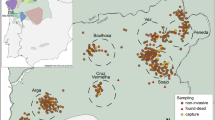Summary
In order to test whether inbreeders are better colonizers, the Flora of the British Isles was surveyed for tabulating the distribution of colonizers and noncolonizers in relation to breeding systems and longevity. Several criteria and difficulties associated with such comparative surveys are briefly discussed. No overwhelming evidence for association was found between longevity and colonizing ability although predominant selfing was found to be significantly more common among the colonizers. However, such evidence for associations among various genetic and ecological factors accounting for high colonizing ability must be interpreted with caution when the role of longevity, ploidy, interfamily and interpopulation genetic variation, uncertainties about the habitat classification, etc., are taken into account
Similar content being viewed by others
References
Babcock EB (1947) The taxonomy, phylogeny, distribution and evolution of Crepis. University of Calif Press Berkeley and Los Angeles
Baker HG (1967) Support for Baker's law — as a rule. Evolution 21:853–856
Baker HG (1974) The evolution of weeds. Ann Rev Ecol Syst 5:1–24
Brown AHD, Marshall DR (1980) The evolutionary genetics of colonizing plants. Paper presented at the Second Intern Congr Syst and Evol Biol, Vancouver
Clapham R, Tutin TG, Warburg EF (1952) Flora of the British Isles, Cambridge
Clausen RT (1975) Sedum of North America, north of the Mexican Plateau. Cornell University Press, Ithaca
East EM (1940) The distribution of self-sterility in the flowering plants. Trans Amer Phil Soc 82:449–518
Frank P (1951) The Philosophy of Science. Prentice-Hall, Englewood cliffs
Fryxell PA (1957) Mode of reproduction of higher plants. Bot Rev 23:135–233
Grant WF (1967) Cytogenetic factors associated with the evolution of weeds. Taxon 16:283–293
Hamrick J, Linhart YB, Milton JB (1979) Relationships between life history characteristics and electrophoretically detectable genetic variation in plants. Ann Rev Ecol Syst 10:175–200
Jain SK (1978) Optimal strategies: Polymorphism, homeostasis and plasticity. In: Solbrig OT, Jain SK, Johnson G and Raven PH (eds) Topics in Plant Population Biology, Columbia U Press
Jain SK (in prep) Genetic characteristics of colonizers. In: Mooney HA (ed) Comparative structural and functional characteristics of Natural and Man-modified Ecosystems. Springer, Berlin Heidelberg New York
Jain SK, Martins SK (1979) Ecological genetics of the colonizing ability of rose clover (Trifolium hirtum All.). Amer J Bot 66:361–366
Lewis H, Lewis M (1955) The genus Clarkia. Univ Calif Publ Bot 20:241
Linhart Y (1976) Density-dependent seed germination strategies in colonizing versus noncolonizing plants species. J Ecol 64:375–380
Maynard-Smith J (1978) The evolution of sex. Cambridge Univ Press
Moldenke AR (1975) Niche specialization and species diversity along a California transect. Oecologia (Berl) 21:219–242
Morley FHW, Katznelson J (1965) Colonization in Australia by Trifolium subterraneum L. In: Baker HG, Stebbins GL (eds) Genetics of colonizing species, 269–286, Academic Press, NY
Mosquin T (1966) Reproductive specialization as a factor in the evolution of Canadian floras. In: Taylor RL, Ludwig RA (eds) The evolution of Canada's flora, 43–65. Univ Toronto Press, Ontario
Muenscher WC (1955) Weeds. The Macmillan Company, New York
Mulligan G (1965) Recent colonization by herbaceous plants in Canada. In: Baker HG, Stebbins GL (eds) The Genetics of Colonizing Species. Academic Press
Munz PA (1973) A California Flora and Supplement. University of California Press. Berkeley, Los Angeles London
Oka HI, Morishima H (in press) Ecological genetics and the evolution of weeds
Ornduff R (1966) A biosystematic survey of the goldfield genus Lasthenia (Compositae: Helenieae). Univ Calif Publ Bot 40:1–92
Pandey KK (1980) Evolution of incompatibility systems in plants: Origin of ‘independent’ and ‘complementary’ control of incompatibility in Angiosperms. New Phytol 84:381–400
Plitmann U, Raven PH, Breedlove DE (1973) The systematics of Lopezieae (Onagraceae). Ann Missouri Bot Garden 60:478–563
Polunin O (1969) Flowers of Europe. Oxford Univ Press, London New York Toronto
Raven PH, Raven TE (1976) The genus Epilobium in Australasia. New Zealand, DSIR bulletin 216
Robbins WW, Bellue MK, Ball WS Weeds of California, State Dept of Agriculture, Sacramento
Stebbins GL (1957) Self-fertilization and population variability in the higher plants. Amer Natur 91:337–354
Stebbins GL (1958) Longevity, habitat, and release of genetic variability in the higher plants. Cold Spring Harbor Symp Quant Biol 23:365–378
Stebbins GL (1965) Colonizing species of the native California flora. In: Baker HG, Stebbins GL (eds) The Genetics of Colonizing species. Academic Press
Williams GC (1975) Sex and Evolution. Princeton Univ Press
Author information
Authors and Affiliations
Rights and permissions
About this article
Cite this article
Price, S.C., Jain, S.K. Are inbreeders better colonizers?. Oecologia 49, 283–286 (1981). https://doi.org/10.1007/BF00349202
Received:
Issue Date:
DOI: https://doi.org/10.1007/BF00349202




